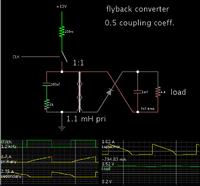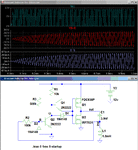freedomtruth
Junior Member level 2
Hi
I'm trying to make a transformer with air core. It's primary is 150 turns and secondary is 180 turns. Dimensions are shown in the picture.
For the primary, I assembled the circuit in the picture and tested frequencies from 3-200 KHz.
But the best result I got in secondary was 3.3V at 8KHz with a 10 Ohm load. What can I do to increase power delivered at the secondary?
My supply voltage is 12V.

I'm trying to make a transformer with air core. It's primary is 150 turns and secondary is 180 turns. Dimensions are shown in the picture.
For the primary, I assembled the circuit in the picture and tested frequencies from 3-200 KHz.
But the best result I got in secondary was 3.3V at 8KHz with a 10 Ohm load. What can I do to increase power delivered at the secondary?
My supply voltage is 12V.

